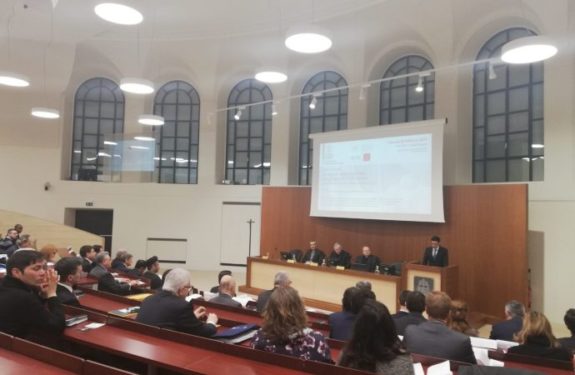
By Claire Giangravè
(Crux) ROME – Though the Catholic Church shares many things in common with other world religions, one thing making it unique is that it’s the only one with its own diplomatic corps that negotiates deals with other states, technically known as “concordats.”
Some of those deals were long overdue, others born of necessity or even desperation – as the saying goes, “You don’t negotiate concordats with your friends” – but a conference in Rome on Thursday suggests they all show a willingness of the Church to adapt to the times.
“The social changes that took place in the last century, especially after World War II, are so diverse that even terms based on basic roots we would like to rely on are quickly expired and change constantly,” said Italian Cardinal Pietro Parolin, the Vatican’s Secretary of State and a veteran of Holy See diplomacy, during his introductory speech.
The event, taking place at the Pontifical Gregorian University in Rome Feb. 28-March 1, is titled “The Holy See’s Agreements with States (XIX-XXI). Models and Mutations: From the Confessional State to Religious Freedom.”
Parolin said that “increasingly varied and heterogeneous societies” challenge the possibility to establish relations based on shared principles, therefore calling the Holy See to adapt to an ever-changing scenario.
Through the years, the Vatican has proved to be nimble at adjusting to changing political and social circumstances, not only in Europe but at a global level.
From quickly establishing relations with new states born from crumbling ancient regimes, to its treaties with Eastern European countries in the former Soviet Bloc and its more recent deal with China on the nomination of bishops, the Holy See has managed to remain relevant on the global chessboard despite changing rules and players.
This doesn’t mean the Catholic Church has a perfect track record in its handling of relationships with states. Some have criticized the deal it signed 90 years ago with Benito Mussolini as legitimizing fascism in Italy, for instance, while others (including the late French President Fancois Mitterand) blamed the Vatican’s hasty recognition of the independence of Croatia and Slovenia in the early 1990s for triggering war in the Balkans.
But according to Parolin, the Second Vatican Council (1962-1965) consolidated the already-existing paradigm for the Holy See’s treaties with states, premised on religious freedom.
“Starting from the Second Vatican Council,” the cardinal said, “religious liberty became a necessary prerogative.”
The 1965 document Dignitatis Humane adopted by the council laid the foundations for the Vatican’s new approach to diplomacy, and it was followed by a flurry of concordats with states based on the principle of religious liberty.
“In concordats, the Holy See does not ask the state to be Defensor Fidei(‘defender of the faith’) or the executive branch of canon law,” he added. “It aims to obtain a civil statute that’s as appropriate as possible to guaranteeing its needs within the shared frame of the right to religious freedom and identity.”
In the past fifty years, the prelate said, the distinction between theological values and concrete political reality was refined within the Holy See, especially in cases where the Catholic community represents a minority within a state.
“The needs of the Church, while being substantially universal, experience variations depending on the places and different situations in every individual state,” Parolin said.
The cardinal said that there “is no prefabricated model” for concordats, which draw inspiration from previous treaties and are aimed at addressing the “pastoral needs and concrete potential to service the churches in the states.”
But the Holy See, he added, can also count on another important heritage born from the Second Vatican Council, which laid down the principle of collegiality that allowed ample space for local churches and bishops’ conferences to lay the groundwork for relations with states.
This development, Parolin said, is not just “a technical advancement” that facilitates the creation of concordats between the Holy See and states, but it “reflects the communal structure of the Church” which starts from the local ecclesial realities.
Today, concordats are at the heart of the Vatican’s soft power diplomacy and have allowed it to carve out its autonomy and freedom, while withstanding the many blows that attempted to undercut the Catholic Church’s relevance.
But according to Parolin, treaties between the Holy See and states can also provide a helpful lens to gauge either “the optimism or pessimism of the Church regarding historic events,” citing the Vatican’s Ostpolitik toward the Soviet Union as an example.
“They can express trust toward those with whom [the Vatican] is signing the concordat,” he said, but also “surrender regarding the present” and even “fear for the future.”
Yet despite it all, he added, concordats between the Holy See and states reflect “the permanent effort to adapt to religious freedoms and realities.”
